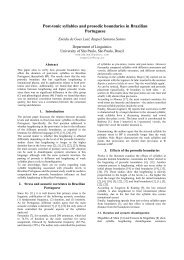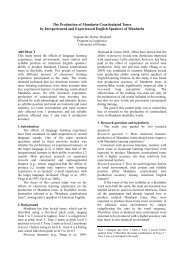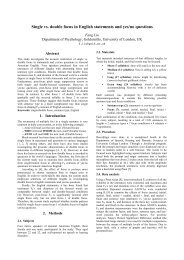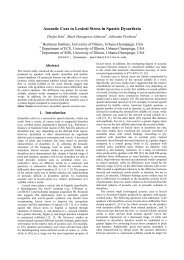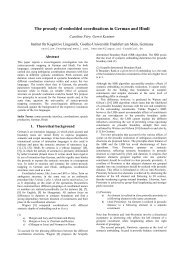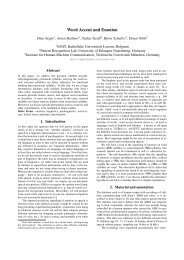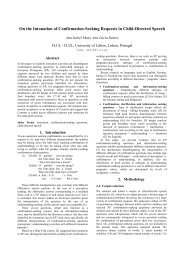C-PROM: An Annotated Corpus for French Prominence ... - GBIF.ch
C-PROM: An Annotated Corpus for French Prominence ... - GBIF.ch
C-PROM: An Annotated Corpus for French Prominence ... - GBIF.ch
You also want an ePaper? Increase the reach of your titles
YUMPU automatically turns print PDFs into web optimized ePapers that Google loves.
Figure 1: Praat screen shot of the utterance: “là qui part de nef Chavant là le boulevard qui passé à côté d’Habitat” [mp-1].<br />
<strong>An</strong>notation tiers are, from top to bottom: phones, syllables (both in SAMPA), delivery (H1 and H2 manual annotations), COMPARE<br />
and graphemic words.<br />
knowledge). Secondly, there is a need <strong>for</strong> defining a contextwindow<br />
<strong>for</strong> prominence identification, to avoid ending up with<br />
large parts of the sound signal without any prominence<br />
detection. Furthermore, the above-mentioned authors agreed<br />
that visualization of the signal can be helpful. Finally, the<br />
study of the acoustic correlates of perceived prominences<br />
showed that while f0 was a good cue <strong>for</strong> automatic<br />
identification, so was duration, provided that hesitation marks<br />
had a specific annotation, to avoid biasing the relative duration<br />
calculations.<br />
3. A Methodology <strong>for</strong> Perceptual<br />
<strong>Prominence</strong> <strong>An</strong>notation<br />
These early studies conducted within the PFC project were<br />
undertaken by the authors of the present paper. They led in<br />
fine to the construction of a multi-genre and multi-speaker<br />
corpus, called C-<strong>PROM</strong>, annotated <strong>for</strong> <strong>Fren<strong>ch</strong></strong> prominence<br />
study by two phonetics experts (see Table 3). The C-<strong>PROM</strong><br />
corpus has been developed with the specific purpose of<br />
building an open data-base to train algorithms <strong>for</strong> semiautomatic<br />
prominence detection.<br />
3.1. Data preparation<br />
A 70-minute corpus, sampled <strong>for</strong> different genres (see Table<br />
3), was automatically segmented into phones, syllables and<br />
orthographic words using Praat [8] and the Easyalign script<br />
[14]. All the transcriptions were manually <strong>ch</strong>ecked. Two<br />
annotators (among the authors of this paper) annotated the<br />
whole corpus following the protocol described in the next<br />
section.<br />
3.2. Protocol<br />
The C-<strong>PROM</strong> coding-protocol takes into account the “errors”<br />
encountered in the first PFC studies, and applies some<br />
recommendations made by the supervisors of the spoken<br />
Dut<strong>ch</strong> corpus coding-protocol [3]. In practice, ea<strong>ch</strong> annotator<br />
starts from an empty annotation tier duplicated from the<br />
syllabic tier (the “delivery” tier in Figure 1), and fills every<br />
interval with the symbols described in Table 1. <strong>An</strong>notation in<br />
conducted by listening to a stret<strong>ch</strong> of spee<strong>ch</strong> of 3 to 5 seconds,<br />
no more than three times (over-listening results in overcoding).<br />
As the annotation of prominences relies on auditory<br />
perception of salience and not on the visual analysis of<br />
acoustic parameters (f0 movements, <strong>for</strong> example),<br />
visualization of the signal was restricted to problematic cases.<br />
The first class of symbols is <strong>for</strong> annotating prominent<br />
syllables. Two symbols can be used (p and P). The distinction<br />
between “p” and “P” is heuristic: it <strong>for</strong>ces the transcribers to<br />
develop more accurate listening and avoids marking only the<br />
strongest prominences. It also avoids the use of an indecision<br />
marker su<strong>ch</strong> as “”. During the comparison of the two manual<br />
annotations, these two categories were merged.<br />
Table 1: <strong>An</strong>notation symbols<br />
1. <strong>Prominence</strong> labeling<br />
P strongly prominent syllable<br />
p weakly prominent syllable<br />
non prominent syllable<br />
2. Delivery labeling<br />
z lengthening connected with a hesitation<br />
@ post-tonic syllabic s<strong>ch</strong>wa (as in "c'est dinguE" [sEde~g@])<br />
$ unaccented post-tonic syllables (appendice)<br />
3. Others<br />
% junk (noise, laugh, cough, etc.)<br />
* breath<br />
_<br />
silence<br />
The delivery labeling is used <strong>for</strong> singling out syllables<br />
whi<strong>ch</strong> have specific properties likely to hamper automatic<br />
prominence identification. The “z” symbol is <strong>for</strong> extralengthened<br />
syllables marking hesitation. Their length can<br />
disturb the calculation of relative duration, as shown by [9].<br />
The marking of hesitation also serves to avoid false automatic<br />
detection of prominence. Since hesitations are often followed<br />
by a silent pause, and since silent pause is often considered a<br />
strong clue <strong>for</strong> prominence detection (boundaries and<br />
prominence being merged in <strong>Fren<strong>ch</strong></strong> ([15] and [16]), it could<br />
introduce mistakes in the automatic detection. Post-tonic<br />
s<strong>ch</strong>wa (@) and appendices ($) are considered non prominent,<br />
but they are specifically annotated because they introduce<br />
irregularity in the final-accent system in <strong>Fren<strong>ch</strong></strong>: post-focal<br />
syllables being problematic with regards to f0 [17], the status<br />
of s<strong>ch</strong>wa as a syllabic nucleus is controversial [18]. The<br />
number of symbols in this “delivery” class can also be<br />
explained by the perspective of a semi-automatic<br />
identification of these specific prosodic phenomena. The last<br />
category of symbols is <strong>for</strong> annotating “silence” and the like. It



